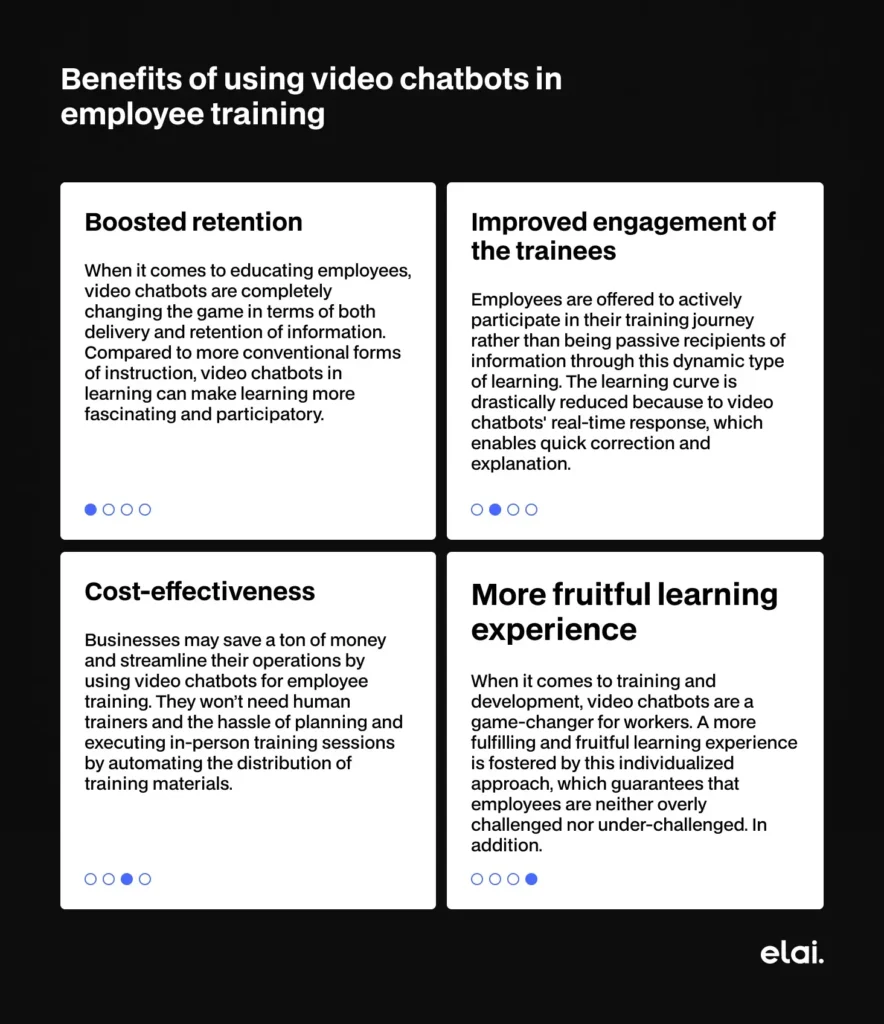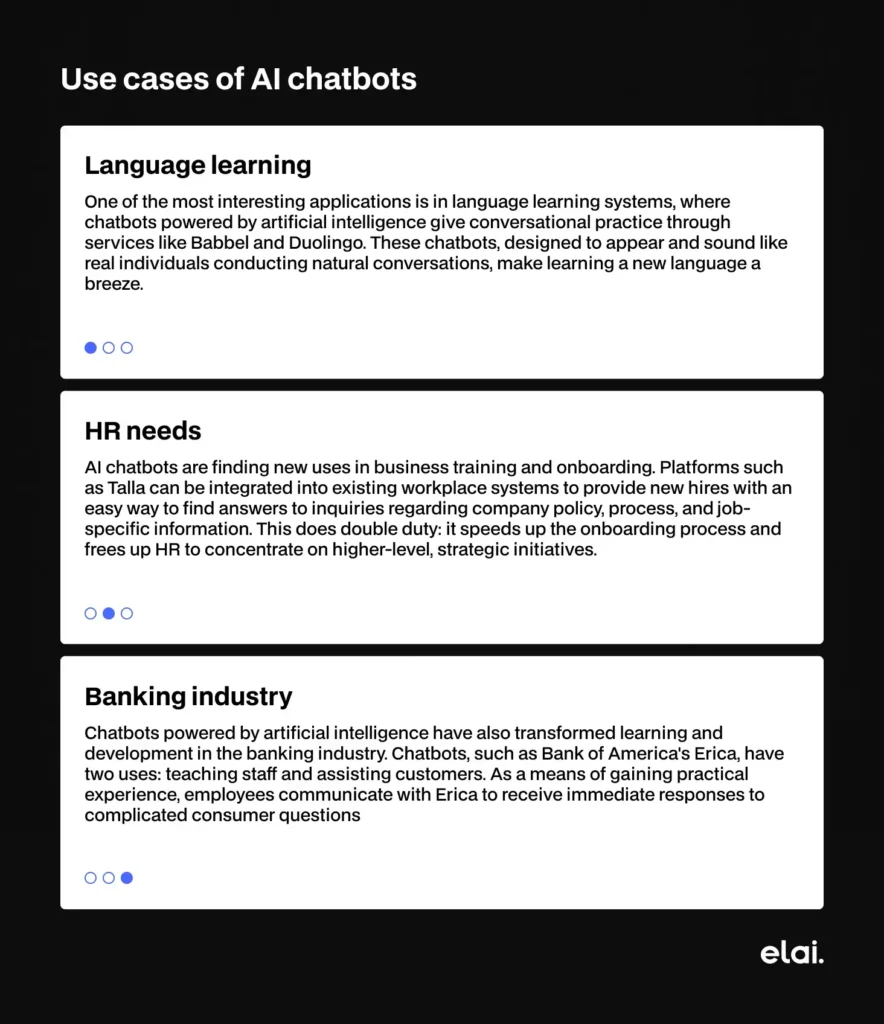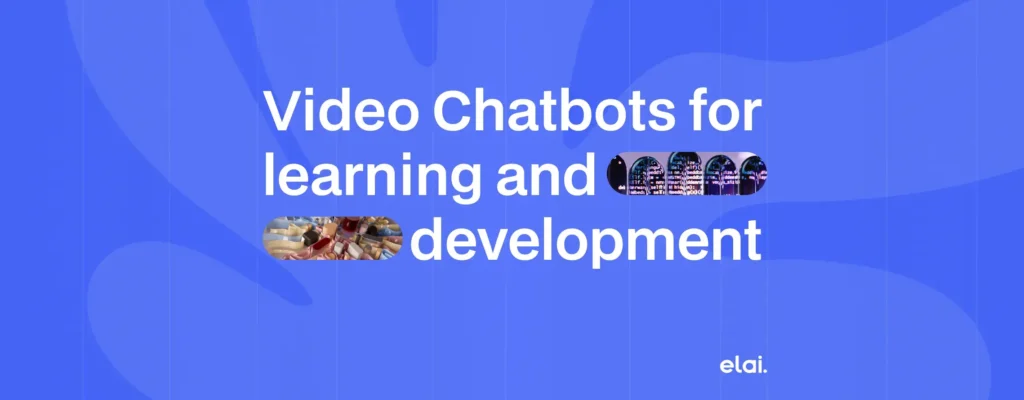Video chatbots are a revolutionary development in the rapidly changing world of digital communication that is transforming the way we engage with technology. Video chatbots are essentially artificial intelligence (AI) systems built to simulate human-like interactions through audio and video interfaces. Visual cues make video chatbots more human and dynamic than text-based chatbots. Modern artificial intelligence (AI) techniques, like machine learning and natural language processing (NLP), are used in this technology to understand what users are asking and answer them quickly. With vocal modulation and facial emotions akin to a real-world discussion, the end product is an incredibly dynamic and engaging experience.
Video chatbots are used in many different fields, but their contribution to education and learning is especially significant. In this sense, AI chatbots for learning are interactive educators who may offer individualized learning experiences rather than merely being instruments for information retrieval. They can use visual aids to help students understand difficult ideas, provide instantaneous video answers to questions, and modify their teaching strategies to fit the needs and speed of each individual student. With this degree of engagement, learning is guaranteed to be an active conversation in which learners are challenged to think critically and are assessed, answered, and engaged in conversation by the chatbot. As a result, video chatbots are transforming traditional educational methods and enabling more accessible, adaptable, and customized learning experiences.
Video chatbot areas of application
Sooner or later, video chatbots will change employee training by making professional growth more dynamic and interactive. By adding a video chatbot for employee training, businesses can make training programs more playful and fit their workers’ different learning styles and speeds. These AI-powered trainers can act out real-life situations and give instant feedback. All of these things make learning more fun and useful. Chatbots for employee training can be changed to fit the needs of any business because they are adaptable and scalable. They can be used to teach new employees, help present employees pick up new skills, or teach people how to be leaders. This improves the learning outcomes and also cuts down on the time and resources that are usually needed to teach the staff.
Regarding chatbots in corporate e-learning, these smart systems make a big difference in how information is given and used at work. Video chatbots can be used as on-demand mentors to help workers with training, support, and direction right when they need it. And this is especially helpful in fast-paced business settings where time is valuable. Employees can talk to these helpers whenever it’s convenient for them, and they can access a lot of information and learning materials through interesting videos. Video chatbots can also offer personalized learning paths that help companies focus on each employee’s strengths and areas where they can improve. This encourages a mindset of continuous learning and growth within businesses.
Learning and development video chatbot can make training material more interesting and easier to remember, which makes corporate training programs more effective. They have a flexible platform that can be used for many things, such as using interactive lessons to help new employees get started and making sure that employees continue to learn and follow the rules. In today’s competitive business world, this drives innovation and development.
Personalized, interesting, and easily accessible training and education are the future that video ai chatbot for education applications in several fields of development and learning reveal. Video chatbots are becoming increasingly useful in many fields, including healthcare education, corporate training, language learning platforms, and more. They provide an innovative combination of personalized learning, instant feedback, and interactive learning that is hard to find in more conventional classroom settings. Organizations can greatly benefit from operational efficiency, cost reduction, and a more knowledgeable and trained workforce through the use of video chatbot in education. Learners may look forward to a more autonomous, adaptable, and engaging learning experience with these AI-driven platforms. With the rapid advancement of technology, video chatbots have limitless potential to improve learning and growth.
Benefits of using video chatbots in employee training
Boosted retention
When it comes to educating employees, video chatbots are completely changing the game in terms of both delivery and retention of information. Compared to more conventional forms of instruction, video chat bots in learning can make learning more fascinating and participatory. Using visual and audio cues, they may simplify and captivate even the most difficult training materials, increasing the likelihood that trainees will retain more of what they learn.
Improved engagement of the trainees
Employees are offered to actively participate in their training journey rather than being passive recipients of information through this dynamic type of learning. The learning curve is drastically reduced because to video chatbots’ real-time response, which enables quick correction and explanation. With the ability to attend training programs whenever and wherever it’s most convenient for employees, learning becomes an integral part of everyday life, making CPD a realistic objective for everyone.
Cost-effectiveness
Businesses may save a ton of money and streamline their operations by using video chatbots for education. They won’t need human trainers and the hassle of planning and executing in-person training sessions by automating the distribution of training materials. Because it creates a consistent experience across distributed teams, this scalability ensures that all employees, regardless of location, receive first-rate training. In addition, video chatbots may collect and evaluate performance data, which can help in planning future training and development initiatives for the firm.
More fruitful learning experience
When it comes to training and development, video chatbots are a game-changer for workers. A more fulfilling and fruitful learning experience is fostered by this individualized approach, which guarantees that employees are neither overly challenged nor under-challenged. In addition, video chatbots enable workers to be self-directed learners, which promotes an active mindset when it comes to career advancement. Video chatbots can boost morale and productivity by facilitating employees’ access to training and advancement possibilities, increasing their job satisfaction.
The use of video chatbots in training employees marks a sea change in professional development, with several advantages that meet the changing demands of businesses and their employees. Video chatbots offer a scalable, cost-effective alternative for businesses looking to improve training speed and effectiveness. They also provide useful data insights for L&D strategy refinement. In addition to streamlining training administration, our AI-driven method encourages a growth mindset, which is essential in today’s fast-paced market. Employees report more job satisfaction and retention when they use video chatbots for individualized, interactive learning that fits their schedules and learning styles.

Use cases of AI chatbots
With their innovative, scalable, and personalized learning experiences, AI chatbots are transforming the Learning and Development (L&D) environment in various sectors.
Language learning
One of the most interesting applications is in language learning systems, where chatbots powered by artificial intelligence give conversational practice through services like Babbel and Duolingo. These chatbots, designed to appear and sound like real individuals conducting natural conversations, make learning a new language a breeze. Through the use of natural language processing, these chatbots enhance the learning experience by providing grammar correction, vocabulary expansion, and skill-level-specific conversational customization, among other features.
HR needs
AI chatbots are finding new uses in business training and onboarding. Platforms such as Talla can be integrated into existing workplace systems to provide new hires with an easy way to find answers to inquiries regarding company policy, process, and job-specific information. This does double duty: it speeds up the onboarding process and frees up HR to concentrate on higher-level, strategic initiatives. To keep employees up-to-date without wasting time in classroom sessions, these chatbots may do more than just assist with onboarding; they can also give personalized training modules and refreshers on business rules or compliance requirements. It also eliminates the awkwardness of asking the wrong question for the newbie.
Banking industry
Chatbots powered by artificial intelligence have also transformed learning and development in the banking industry. Chatbots, such as Bank of America’s Erica, have two uses: teaching staff and assisting customers. As a means of gaining practical experience, employees communicate with Erica to receive immediate responses to complicated consumer questions. This practical approach ensures that staff remain well-informed on the most recent banking technologies, laws, and financial products, which in turn improves their capacity to provide excellent customer service.

How to add video chatbot to your L&D toolset
Efficiency and participation in your training programs can be greatly enhanced by adding a staff training video chatbot to your L&D toolbox. It is essential to have a well-defined plan that corresponds to the organization’s training objectives before beginning this trip without specialized platforms. The first stage in implementing a video chatbot into your learning and development program is to determine its primary objectives and how these goals might be improved. With their versatility, video chatbots can be used for a variety of educational objectives, such as interactive onboarding and continual professional development.
Considerations like user experience quality, compatibility with current L&D systems, and the ability to personalize the chatbot are important when deciding which video chatbot solution is right for your business. If you want your videos to mimic real-life situations, answer questions, and give immediate feedback, you need a platform that lets you do just that. The chatbot’s ability to provide useful training depends on the scripts and scenarios that are designed to mimic real-life problems and learning goals. Trainers should be able to simply update and enhance chatbot interactions based on growing training requirements and feedback. Hence, easy content management tools should be an option with the selected solution.
Lastly, it is crucial to execute and evaluate an educational video chatbot for answering queries thoroughly if you want to incorporate it into your L&D plan. In order to keep the chatbot a useful and evolving part of your company’s L&D framework, it is important to continuously analyze and alter its functionality depending on this data. Organizations can greatly improve their employees’ learning experience by carefully choosing, personalizing, and integrating a video chatbot solution. This will make the learning process more interactive, personalized, and effective.
As an example, Elai.io lets you build an AI-powered video chatbot that you can incorporate into your app or website. With this solution, your consumers will feel as though they are interacting with a real assistant or expert. A talking head provides voiceovers for the program’s on-screen phrases. When you want to personalize your service, this is a lifesaver. You might stand out from the crowd using one of the dozens of voices or avatars available on Elai.io.
Conclusion
Exploring chatbots—particularly video chatbots—and how they may be used in L&D has shown a revolutionary potential to change the way training and education are traditionally done. Chatbots introduced a new layer of engagement and personalization, which may transform corporate training with tailored, scalable learning solutions. They simplify and automate the distribution of training materials and provide data on staff performance that can inform L&D strategy moving forward. Employees can experience greater job satisfaction and career advancement with the help of chatbots since they provide a more engaging and adaptable learning experience that considers their individual learning methods and speed.
To sum up, the introduction of AI and video chatbots into training and education is more than just a technical development; it represents a societal movement towards learning spaces that are more interactive, adaptable, and tailored to each individual’s needs. L&D uses of these technologies are only going to grow in the future, opening the door to a world where learning is accessible, engaging, and adapted to the unique requirements of employees all over the world. Chatbots’ potential in learning and development is limitless, yet their implementation is in its infancy.
FAQ
Can I create AI video chatbot for employee training?
Making an AI video chatbot to train employees is surely a way to provide them with engaging, tailored lessons.
How are chatbots used in training?
In training, chatbots mimic real-world situations, give learners immediate feedback, and facilitate on-demand learning.
How can chatbot be used in the workplace?
Chatbots have several potential uses in the business world, including the automation of customer service, the simplification of human resources inquiries, and the facilitation of onboarding and ongoing training for employees.

